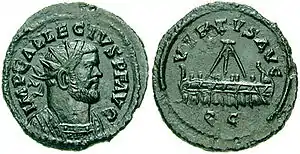Quinarius
The quinarius (plural: quinarii[1]) was a small silver Roman coin valued at half a denarius.


The quinarius was struck for a few years, along with the silver sestertius, following the introduction of the denarius in 211 BC. At this time the quinarius was valued at 5 asses. The coin was reintroduced in 101 BC as a replacement for the victoriatus, this time valued at 8 asses due to retariffing of the denarius to 16 asses in 118 BC. For a few years following its reintroduction, large quantities of quinarii were produced, mostly for circulation in Gaul. The coin was produced sporadically until the 3rd century.
The term gold quinarius or quinarius aureus is used to describe the half-aureus, which is valued at 12.5 denarii. This term has no ancient authority.
References
- Oxford English Dictionary, Webster's Third New International Dictionary of the English Language, Unabridged.
